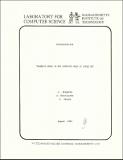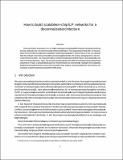Browsing LCS Publications by Title
Now showing items 492-511 of 1163
-
Hierarchical Correctness Proofs for Distributed Algorithms
(1987-04)This thesis introduces a new model for distributed computation in asynchronous networks, the input-output automaton. This simple, powerful model captures in a novel way the game-theoretical interaction between a system ... -
Hierarchical Inequality Reasoning
(1987-02)This paper describes a program called BOUNDER that proves inequalities between elementary functions over finite sets of constraints. Previous inequality algorithms perform well on some subset of the elementary functions, ... -
High Level Expression of Semantic Integrity Specifications in a Relational Data Base System
(1976-09)The "semantic integrity" of a data base is said to be violated when the data base ceases to represent a legitimate configuration of the application environment it is intended to model. In the context of the relational ... -
High Level VAL Constructs in a Static Data Flow Machine
(1981-06)The Dennis-Misunas Form 1 Data Flow Machine can best be described as a static and scalar machine. Despite these two limiting characteristics, it is still possible to translate the whole of the functional programming ... -
A High-level Signal Processing Programming Language
(1988-03)The motivations for an abstract, diagrammatic signal processing language are presented along with a study of the semantics that such language should have. D-PICT, the proposed Digital Signal Processing Pictorial Language, ... -
High-Performance All-Software Distributed Shared Memory
(1996-02)The C Region Library (CRL) is a new all-software distributed shared memory (DSM) system. CRL requires no special compiler, hardware, or operating system support beyond the ability to send and receive messages between ... -
A High-performance Retargetable Simulator for Parallel Architectures
(1991-06)The complexity of the interaction between software and hardware in MIMD machines makes experimental evaluation of parallel programs an import complement to theoretical analysis. Traditional techniques used to monitor the ... -
A History of CLU
(1993-09)The idea of a data abstraction has had a significant impact on the development of programming languages and on programming methodology. CLU was the first implemented programming language to provide direct linguistic support ... -
Hoare's Logic Is Not Complete When It Could Be
(1982-08)It is known (cf.[2]) that is the Hoare rules are complete for a first-order structure A, then the set of partial correctness assertions true over A is recursive in the first-order theory of A. We show that the converse is ... -
How Can We Compute with Arrays of Nanstructures?
(1994-08)In part the goal of the Ultra Program is to extract useful computation from nanometer scale effects. To accomplish this goal those of us who are computer scientists must communicate clearly to those of you who are chemists ... -
How to Assemble Tree Machines
(1984-03)Many researchers have proposed that ensembles of processing elements be organized as trees. This paper explores how large tree machines can be assembled efficiently from smaller components. A principal constraint considered ... -
How to Build Scalable On-Chip ILP Networks for a Decentralized Architecture
(2000-04)The era of billion transistors-on-a-chip is creating a completely different set of design constraints, forcing radically new microprocessor archiecture designs. This paper examines a few of the possible microarchitectures ... -
How to Construct Random Functions
(1982-11)We assume that functions that are one-way in a very weak sense exist. We prove that in probabilitic polynomial time it is possible to construct deterministic polynomial time computable functions g:{1,…,2^k} -> {1,…,2^k} ... -
How to Share a Secret
(1979-05)In this paper we show how to divide data D into n pieces in such a way that D is easily reconstructable from any k pieces, but even complete knowledge of k-1 pieces reveals absolutely no information about D. This technique ... -
How to Sign Given Any Trapdoor Permutation
(1990-06)We present a digital signature scheme which is based on the existence of any trapdoor permutation. Our scheme is secure in the strongest possible natural sense: namely, it is secure against existential forgery under ... -
HULA: An Efficient Protocol for Reliable Delivery of Messages
(1997-07)We present a new protocol for reliable delivery of messages over a network that might lose, duplicate, reorder, or arbitrarily delay packets. It is the first protocol that guarantees exactly-once and ordered delivery on a ... -
Hybrid Atomicity for Nested Transactions
(1992-10)This paper defines the notion of hybrid atomicity for nested transaction systems, and presents and verifies an algorithm providing this property. Hybrid atomicity is a modular property; it allows the correctness of a system ... -
Hybrid Caching for Scalable Oject Systems (Think Globally, Act Locally)
(1994-04)Object-based client caching allows clients to keep more frequently accessed objects while discarding colder objects that reside on the same page. However, when these objects are modified and sent to the server, it may need ... -
Hybrid I/O Automata
(1995-12)We propose a new hybrid I/O automaton model that is capable of describing both continuous and discrete behavior. The model, which extends the timed I/O automaton model of [12, 7] and the phase transition system models of ...



















